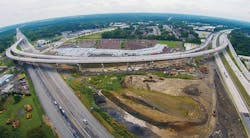NO. 2: PA Turnpike/I-95 Interchange (Stage 1)
Construction of the Pennsylvania Turnpike (I-276) was completed throughout the Mid-Atlantic region in 1956, while I-95 was constructed in 1969 without a direct connection to the Turnpike.
This created confusion for regional travelers and resulted in increased congestion on arterials used to make the connection between the two interstates. I-95, which was often hailed as the longest north-south interstate in the country, was discontinuous for a short nearby stretch in the state of New Jersey. To address this discontinuity, the 1982 Federal Surface Transportation Assistance Act (STAA) and the 1985 Pennsylvania Act 61 named the PA Turnpike Commission as the lead agency on a project to complete I-95 using the PA and NJ Turnpikes via an interchange between I-95 and the PA Turnpike.
Environmental impact studies began as far back as 1992, the result of which was that impacts were minimized to the local environment through installation of 12,500 linear ft of retaining wall, 4,500 linear ft of noise wall, 14 new stormwater basins, and 43,000 linear ft of drainage pipe.
In order to bridge a financial gap introduced by a FHWA cost estimate review that determined funding set aside for the project almost 30 years prior was vastly inadequate to finance all prerequisite construction, the project was broken into three stages, the first of which prioritized addressing the discontinuity of I-95, literally the final segment required to complete the entire U.S. National Highway System as originally legislated in 1956. The project’s Stage 1 components, totaling $450 million, have been mainly comprised of two high-speed interchange movements required to complete I-95’s missing link along the east coast.
Prior to the construction of these high-speed flyover structures, however, prerequisite Stage 1 contracts included the construction of compensatory wetland, stream and threatened and endangered (T&E) mitigation sites. Additional contracts included the replacement of four overhead bridge structures to accommodate widening of the Turnpike and I-95, ITS systems, construction of a new PA Turnpike mainline toll plaza, and the conversion of the Delaware River Bridge toll plaza to a cashless tolling facility. Stage 2 includes the replacement of the remaining overhead bridge structures to accommodate widening of the Turnpike mainline, reconstruction and widening of portions of the interstates, and construction of the remaining six ramps to fully connect the interstates. (Stage 3 will involve the replacement of the Delaware River Bridge to provide additional traffic capacity and mainline improvements on the bridge approaches in PA and NJ.)
Work had to be maintained in live traffic, which presented innumerable challenges—e.g., in order to relocate an existing unnamed stream adjacent to EB I-276, a new 136-ft precast reinforced concrete box culvert was jacked under live traffic during a continuous operation. The 1980s legislation mandated the rerouting of I-95 along the PA and NJ Turnpikes, which also necessitated the redesignation of 20 miles of what was originally I-95. The original segment to be redesignated, however, was not a strict north/south or east/west configuration; rather it was circuitous in nature. As such, the project team redesignated the segment as I-295, in order to categorize the segment as a loop/beltway connected with I-95 and both termini.
Mark Raup, P.E., Senior Engineer Project Manager for the Turnpike Commission, had this to say: “The PA Turnpike is proud to have led the efforts to complete Stage 1 of this challenging program which completes I-95 and the originally legislated U.S. Interstate Highway network. The talented group of professionals involved, including our state and federal partners, who worked together as a true team, were creative and dedicated, all while exhibiting sensitivity to the surrounding environment and communities.”
